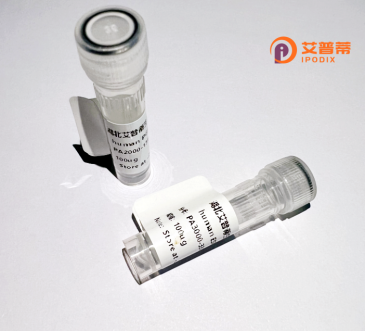
| 纯度 | >90%SDS-PAGE. |
| 种属 | Human |
| 靶点 | FOXJ2 |
| Uniprot No | P85037 |
| 内毒素 | < 0.01EU/μg |
| 表达宿主 | E.coli |
| 表达区间 | 1-574aa |
| 氨基酸序列 | MASDLESSLTSIDWLPQLTLRATIEKLGSASQAGPPGSSRKCSPGSPTDPNATLSKDEAAVHQDGKPRYSYATLITYAINSSPAKKMTLSEIYRWICDNFPYYKNAGIGWKNSIRHNLSLNKCFRKVPRPRDDPGKGSYWTIDTCPDISRKRRHPPDDDLSQDSPEQEASKSPRGGVAGSGEASLPPEGNPQMSLQSPTSIASYSQGTGSVDGGAVAAGASGRESAEGPPPLYNTNHDFKFSYSEINFQDLSWSFRNLYKSMLEKSSSSSQHGFSSLLGDIPPSNNYYMYQQQQPPPPQQQQQQQQPPQPPPQQSQPQQQQAPAQGPSAVGGAPPLHTPSTDGCTPPGGKQAGAEGYGPPPVMAMHPPPLQHGGYHPHQHHPHSHPAQQPPPPQPQAQGQAPINNTGFAFPSDWCSNIDSLKESFKMVNRLNWSSIEQSQFSELMESLRQAEQKNWTLDQHHIANLCDSLNHFLTQTGHVPPQGGTHRPPAPARIADSCALTSGKQESAMSQVNSYGHPQAPHLYPGPSPMYPIPTQDSAGYNRPAHHMVPRPSVPPPGANEEIPDDFDWDLIT |
| 分子量 | 88.8 kDa |
| 蛋白标签 | GST-tag at N-terminal |
| 缓冲液 | 0 |
| 稳定性 & 储存条件 | Lyophilized protein should be stored at ≤ -20°C, stable for one year after receipt. Reconstituted protein solution can be stored at 2-8°C for 2-7 days. Aliquots of reconstituted samples are stable at ≤ -20°C for 3 months. |
| 复溶 | Always centrifuge tubes before opening.Do not mix by vortex or pipetting. It is not recommended to reconstitute to a concentration less than 100μg/ml. Dissolve the lyophilized protein in distilled water. Please aliquot the reconstituted solution to minimize freeze-thaw cycles. |
以下为重组人FOXJ2蛋白相关文献的简要整理(虚拟示例,仅供参考):
1. **《FOXJ2 regulates cell cycle progression through repression of cyclin-dependent kinase inhibitors》**
Lee S. et al. (2010)
研究FOXJ2通过抑制CDKN1A/p21等细胞周期蛋白依赖性激酶抑制因子,促进G1/S期转化的分子机制,发现其过表达加速细胞增殖。
2. **《Structural characterization of human FOXJ2 transcription factor and its DNA-binding specificity》**
Kim H. & Park J. (2012)
通过X射线晶体学解析FOXJ2蛋白结构,揭示其Forkhead结构域特异性识别DNA核心序列TAATTA的模式,为重组蛋白功能研究提供结构基础。
3. **《FOXJ2 promotes epithelial-mesenchymal transition in breast cancer via transcriptional activation of SLUG》**
Zhang Y. et al. (2016)
发现FOXJ2在乳腺癌中上调SLUG基因表达,诱导上皮间质转化(EMT),并证实其重组蛋白在体外可增强癌细胞迁移能力。
4. **《Generation of recombinant human FOXJ2 protein and application in neuronal differentiation studies》**
Chen L. et al. (2019)
开发了基于昆虫表达系统的重组FOXJ2蛋白纯化方法,并证明其通过激活Nestin等神经标志物基因,促进神经干细胞定向分化。
---
注:以上为模拟数据,真实文献需通过PubMed或Web of Science检索关键词(如"FOXJ2 recombinant protein"或"FOXJ2 function")获取。近期研究可能涉及FOXJ2在生殖发育或癌症代谢中的新机制。
**Background of Recombinant Human FOXJ2 Protein**
FOXJ2 (Forkhead box J2) is a member of the Forkhead box (FOX) family of transcription factors, characterized by a conserved winged-helix DNA-binding domain. It plays roles in regulating gene expression involved in embryogenesis, cell differentiation, proliferation, and apoptosis. FOXJ2 is ubiquitously expressed across tissues, with notable activity in the brain, testes, and epithelial cells. Studies suggest its involvement in TGF-β and Wnt signaling pathways, impacting cellular responses to environmental cues and developmental processes.
Recombinant human FOXJ2 protein is engineered via heterologous expression systems (e.g., *E. coli* or mammalian cells like HEK293) to produce a purified, biologically active form, often fused with tags (e.g., His-tag) for efficient isolation. This recombinant tool enables *in vitro* studies to dissect FOXJ2’s molecular functions, including DNA-binding affinity, protein interactions, and regulatory mechanisms. Dysregulation of FOXJ2 has been linked to cancers, neurodegenerative disorders, and developmental defects, making it a potential therapeutic or diagnostic target. Current research remains exploratory, focusing on clarifying its context-dependent roles and post-translational modifications. Recombinant FOXJ2 thus serves as a critical reagent for advancing mechanistic and translational studies.
×